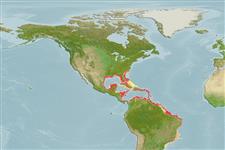Common names from other countries
Teleostei (teleosts) >
Eupercaria/misc (Various families in series Eupercaria) >
Gerreidae (Mojarras)
Etymology: Eugerres: Greek, eu = good, well + Latin, gerres = a kind of anchovies; cited by Plinius.
More on author: Cuvier.
Environment: milieu / climate zone / depth range / distribution range
Ecology
Marine; freshwater; brackish; demersal. Subtropical; 35°N - 33°S, 99°W - 34°W
Western Atlantic: South Carolina to western Florida, USA (Ref. 26938) and the entire Gulf of Mexico to Brazil; absent from Bahamas and smaller islands in West Indies.
Length at first maturity / Size / Weight / Age
Maturity: Lm 22.0, range 18 - ? cm
Max length : 40.0 cm TL male/unsexed; (Ref. 3722); common length : 30.0 cm TL male/unsexed; (Ref. 3722); max. published weight: 1.0 kg (Ref. 4699)
Inhabits shallow coastal waters and common in brackish waters (Ref. 36880), mostly over mud bottoms in mangrove-lined creeks and lagoons (Ref. 3722); often entering a considerable distance into freshwaters (Ref. 36880). Feeds on aquatic insects, crustaceans, micro-bivalves and detritus (Ref. 36880). Marketed fresh; processed into fishmeal (Ref. 3722).
Life cycle and mating behavior
Maturity | Reproduction | Spawning | Eggs | Fecundity | Larvae
Randall, J.E. and R. Vergara R., 1978. Gerreidae. In W. Fischer (ed.) FAO species identification sheets for fishery purposes. Western Central Atlantic (Fishing Area 31). Vol. 2. pag.var. (Ref. 3722)
IUCN Red List Status (Ref. 130435)
CITES (Ref. 128078)
Not Evaluated
Threat to humans
Harmless
Human uses
Fisheries: minor commercial; gamefish: yes
More information
ReferencesAquacultureAquaculture profileStrainsGeneticsElectrophoresesHeritabilityDiseasesProcessingMass conversion
Tools
Special reports
Download XML
Internet sources
Estimates based on models
Preferred temperature (Ref.
115969): 24.4 - 28, mean 26.9 (based on 270 cells).
Phylogenetic diversity index (Ref.
82804): PD
50 = 0.5156 [Uniqueness, from 0.5 = low to 2.0 = high].
Bayesian length-weight: a=0.01479 (0.01088 - 0.02010), b=3.03 (2.98 - 3.08), in cm Total Length, based on LWR estimates for this species (Ref.
93245).
Trophic level (Ref.
69278): 2.2 ±0.0 se; based on diet studies.
Resilience (Ref.
120179): Medium, minimum population doubling time 1.4 - 4.4 years (K=0.17-0.32).
Fishing Vulnerability (Ref.
59153): Low to moderate vulnerability (34 of 100).
